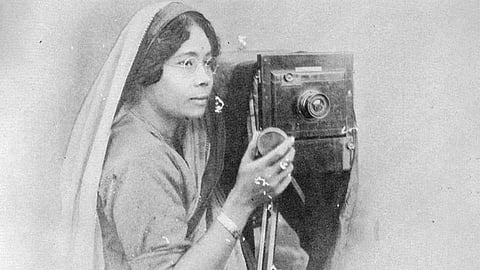
- HOMEGROWN WORLD
- #HGCREATORS
- #HGEXPLORE
- #HGVOICES
- #HGSHOP
- CAREERS
- ABOUT US
- CONTACT US

Even today, as we find ourselves in the thick of modernity, patriarchy, although weakened over time, has still managed to hold us back. According to the International Labour Organization (ILO), in India, the gender pay gap still stands at 27 percent. If that’s the case in 2023, you can only imagine what the viability of employment for Indian women might have been like in the early 1900s. Even during such times when orthodox thought rampantly pervaded society, there were a few women who were smashing patriarchy through their personal practice. In other words, even in a thoroughly male-dominated world and time, they managed to carve out their own identity and cement their personal history.
Introducing Annapurna Dutta, who emerged as a trailblazing figure; challenging societal norms and capturing remarkable portraits through her lens at a time when studio photography was predominantly a male-dominated profession. Born in 1894 in undivided Bengal, Dutta paved the way as one of the first professional female photographers of her time.
During the 1920s, Dutta's talent as a photographer came to the forefront, with much of her prolific work produced in the ensuing decades. At a time when it was unconventional for women to work outside the home, Dutta charted her own path. Eschewing the traditional studio setup, she ventured into the homes of affluent Indian families, capturing intimate portraits that reflected the essence of domestic life. Clad in traditional attire, her subjects were often surrounded by their loved ones and cherished possessions. She also developed and printed the photographs herself.
Notably, Dutta's lens extended beyond the boundaries of class and religion. She ventured into the households of the Muslim elite, photographing influential figures such as renowned politician Hassan Suhrawardy, the esteemed poet Jasimuddin, and the celebrated singer Abbas Uddin Ahmed. While the Muslim women she photographed were often shown in purdah, it is a testament to Dutta's skill and sensitivity that she was granted access to their private spaces.
One of Dutta's most iconic images is a self-portrait, capturing her poised beside her plate camera in a three-quarter profile. Holding the lens cap and gazing beyond the frame, she exudes confidence and passion for her craft. Her attire, reflecting her married status, serves as a reminder that even while adhering to the expectations of traditional domestic life, she managed to embark on new endeavors like photography. Her husband was a lawyer, by profession, as well as an amateur photographer. This powerful self-portrait, along with other glass plate negatives, now forms part of the collection held by her son, Amarendranath Dutta.
Annapurna Dutta's legacy as a pioneering female photographer endures. Her work showcases a distinctive perspective that defied the norms of her era. She was endearingly called "Photographer Mashima" ( Mashima, in Bengali, is a term of affection and veneration for a mother/aunt-like figure) by her younger contemporaries. She immortalized moments in time, bringing life and artistry to her subjects. Today, her photographs continue to inspire a new generation of photographers, who recognize the importance of breaking barriers and embracing their passion.
In 1976, at the age of eighty-two, Annapurna Dutta passed away, leaving behind a remarkable body of work that will forever be etched in the annals of photography history. Her contributions as an artist, along with the likes of other early 20th-century Bengali female photographers Jnanadanandini Debi, Sarojini Ghosh, Chanchalabala Dasi, Mira Choudhuri and Indira Debi serve as a testament to the indomitable spirit and creative vision of women in art. Her body of work emphatically challenged the status quo and will continue to inspire generations of women.
